Reserve Bank of Australia Annual Report – 1977 Economic Activity
The main developments in Australia and in other developed countries were in several ways parallel (though with a lag) in 1976/77; the movement up from earlier low levels of output and demand began firmly, but slowed later in the year; growth in private investment was sluggish, and unemployment, which was high when the year began, trended higher. Another common thread was concern with the absolute size and rate of growth of the public sector. As in other countries, some modest gains were made in Australia in reducing inflation from the high levels of recent years, but rates of increase in prices and wages remained uncomfortably high at the end of the financial year.
Some Features of Recent Economic Fluctuations
Since World War II, the Australian economy has experienced six recessions. Three of these, in 1951–52, 1960–61 and 1974–75, could, on the basis of the substantial declines in output and employment, be described as major. The other three, in 1955–58, 1965–66 and 1970–72, were milder and, though product declined slightly in each case, for some other aggregates the recession was evident only in a slowdown in rates of growth, and not in absolute declines. Movements in some important indicators of economic activity in the three major recessions and the 1970–72 experience are shown in Chart 8.
There are some important differences between current experience and earlier major economic fluctuations. The downturns in activity and employment in 1974–75 were not as pronounced as in 1951–52, but were comparable with the 1960–61 recession. On the other hand, the latest recession has lasted longer than any of the earlier downturns; moreover, the recovery in non-farm output has been hesitant and, twelve quarters after the previous peak, non-farm output is not far above this level. The slowness in the recovery in employment is even more marked, with only very little growth since the trough of 1975. Correspondingly, unemployment, which typically rose sharply but also fell sharply in earlier periods, rose to much higher levels in this last recession and has remained high.
Quarterly data for real investment over the 1951–52 period are not available but, of the data shown on Chart 8, the current decline in this component of demand (as in a number of western economies) has been much sharper than in earlier cycles. This may be linked with the much sharper fall in the profit ratio and its ensuing slow recovery (as shown in the bottom middle panel of the chart).
The slowness of recent upward movements in output, employment and investment may be viewed in the context of continued high inflation. The period of inflation most similar to the current experience was in the 1951–52 period. On that occasion, however, inflation fell away quickly; the present inflation has, after a small initial drop, persisted. In these circumstances, inflationary expectations seem to have persisted also and to have worked to limit any marked improvement in business and consumer confidence. The experience of a sequence of major changes in the direction of economic policies may also have slowed the restoration of confidence. In these circumstances, both households and businesses have reduced the scale of their activities, and aggregate demand has remained subdued. The description below of aspects of economic activity in 1976/77 draws out the fragile nature of the upward movement in spending and activity.
Demand
Movements in aggregate spending over the second half of 1975/76 confirmed that the economy had moved to higher levels of activity and, after showing little net change in the previous two years, aggregate turnover of goods and services looks to have been about 5 per cent higher in 1976/77 than in 1975/76. There was, however, a renewed faltering in the growth of demand during the course of the year. This weakening was largely the result of declines in private consumption, dwelling investment and exports as well as a slowing in the rate of stock accumulation.
8 Patterns of Economic Fluctuations — Australia
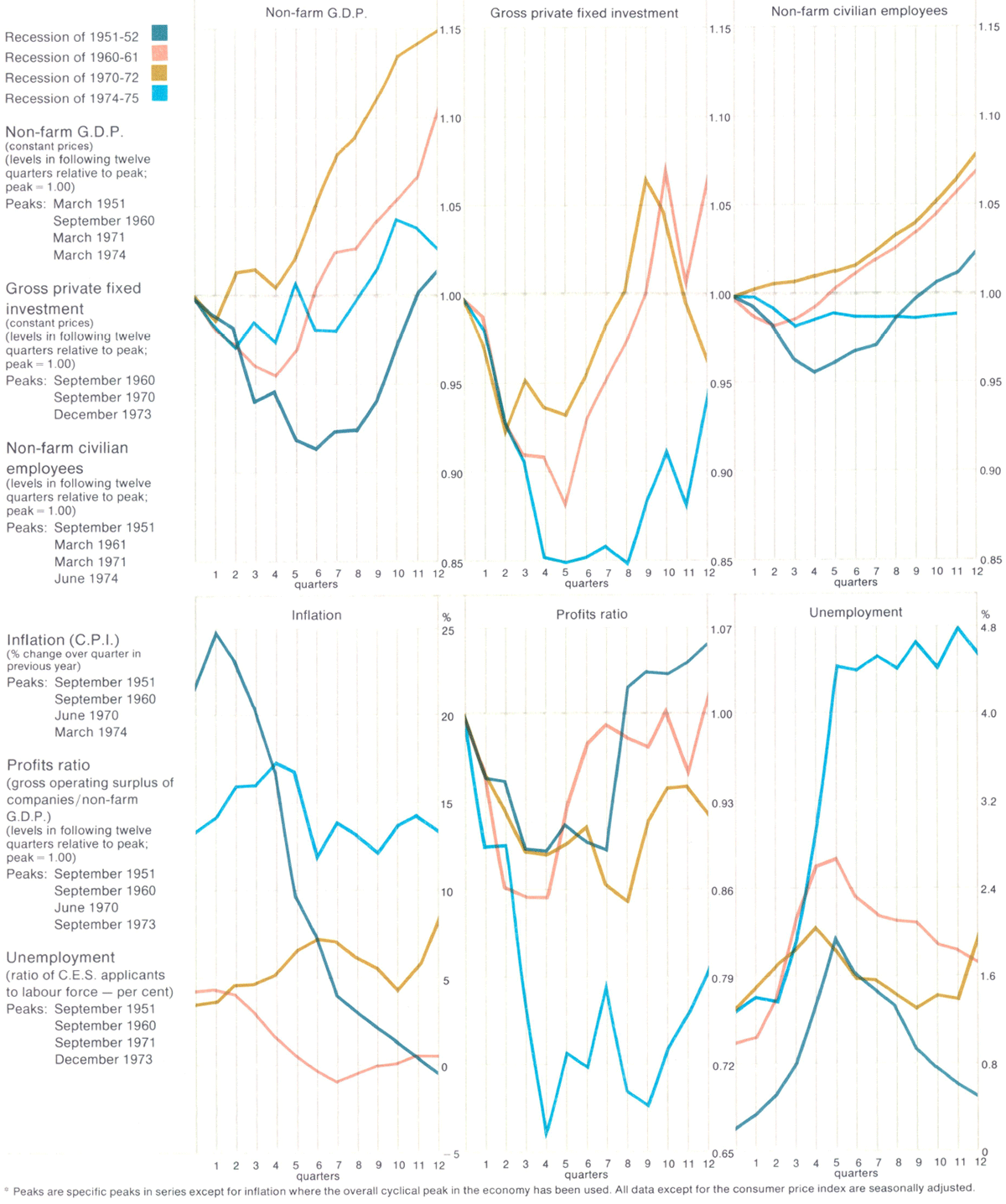
9 Gross National Expenditure
constant prices – seasonally adjusted
(1971/72 = 100)
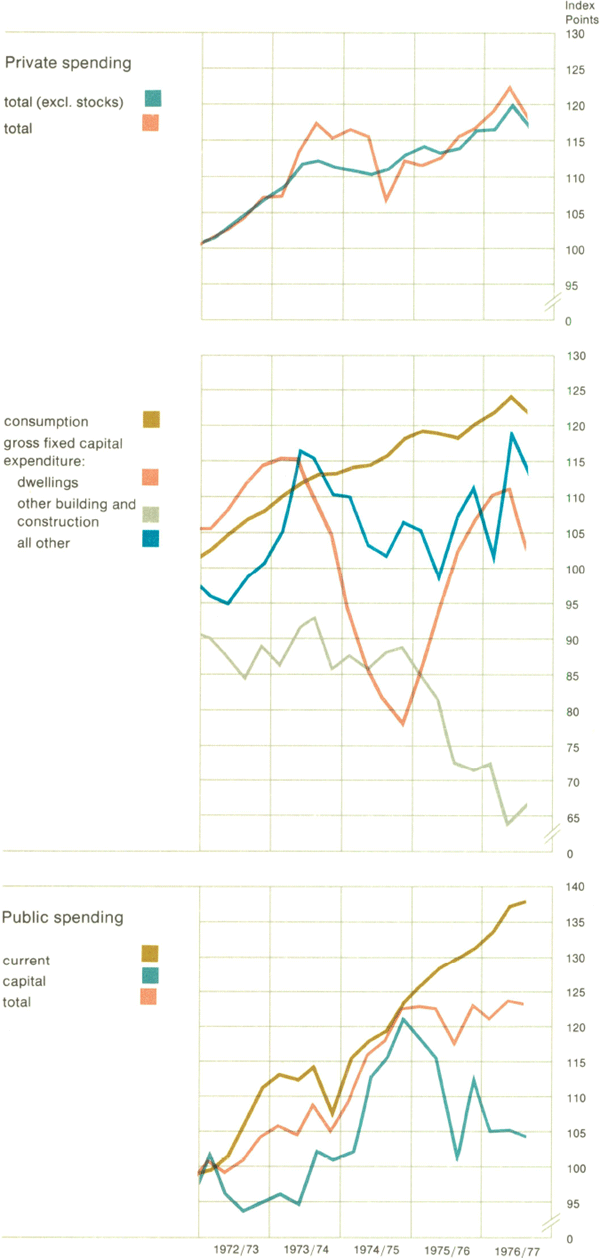
Foreign demand for Australia's products was strong early in the financial year but weakened in the second half; exports of goods and services valued at constant prices increased by around 8 per cent in 1976/77. Real gross national expenditure was about 4 per cent higher in 1976/77 than in the previous year. A major factor contributing to this growth was a sizeable build-up in private non-farm stocks. The rise in stocks was strong in the first half of the year and broadly based across industry, with stocks of goods at all levels of processing rising strongly. Farm stocks fell in 1976/77, largely as a result of decline in holdings of wool by the Australian Wool Corporation.
The accumulation of non-farm stocks over 1976 and, to a lesser extent, the first half of 1977 was substantial. In part, it represented a technical reaction to the shedding of stocks over 1975 to levels below those desired; it may also have reflected some accumulation of goods in the first half of 1976/77 in anticipation of a possible devaluation with the subsequent high import flows coming on to slack domestic goods markets. As well, stocks may have been increased involuntarily because the general potential for final sales in 1976/77 (especially in the second half of the year) may have been over-estimated.
Final domestic spending (or gross national expenditure excluding stocks and the statistical discrepancy) rose by about 2.5 per cent in 1976/77, around half a percentage point less than in 1975/76. This lower outcome was largely the result of subdued growth of public spending which grew by 1 per cent compared with 4 per cent in 1975/76. Private final spending appears to have grown by 3 per cent, about the same pace as in 1975/76.
Growth of real private consumption in 1976/77 at about 3 per cent was much the same as in the previous two years. Consumption grew rapidly in the first half of the year, partly because of a surge in expenditure on durables; this strong rise probably reflected the bringing forward of some consumption expenditures (particularly motor vehicles in the December quarter) in anticipation of price rises following devaluation. Consumption declined in the second half of the year.
As in 1975/76, the higher level of consumption in 1976/77 took place against the background of a slow growth in real household disposable income, the level of which has only increased slightly since 1974/75. With consumption growing more quickly than disposable income, the household saving ratio showed a further decline from an annual average of around 15 per cent in 1975/76 to a little above 14 per cent in 1976/77, about 3 percentage points below its peak annual level in 1974/75. At the end of 1976/77, however, this ratio was still around 4 percentage points above its average level during the 1960's.
Growth in private fixed investment demand was also slow in 1976/77. Overall, total private fixed investment rose by around 3.5 per cent in 1976/77, about 2 percentage points faster than the 1975/76 movement. Investment in dwellings and in plant and equipment rose in 1976/77 but there was a further sizeable decline in real outlays for non-residential construction.
As indicated in Chart 9, dwelling investment has shown pronounced fluctuations in the past four years. While the decline to the trough during 1974 was rapid, the upward movement that began in the middle of 1975 has also been quick and, after increasing by 14 per cent in 1975/76, dwelling investment increased by a further 10 per cent in 1976/77. The initial rapid pick-up owed a good deal to the large injections of finance (partly from government sources) which were made in early 1975 and in 1976; the continuing abundance of credit through much of that year sustained a high level of activity in housing. However, the growth in new dwelling activity was not matched in all States by growth in demand and some build-up of stocks occurred around the end of 1976. Housing lending was a little slower in the early months of 1977 and there was some decrease in dwelling investment over the second half of 1976/77. Movements over the past couple of years in dwelling activity have been uneven both between types of dwellings and across States. The increase in construction of detached dwellings has been markedly stronger than for multi-unit structures.
10 Selected Ratios
seasonally adjusted – per cent
half yearly
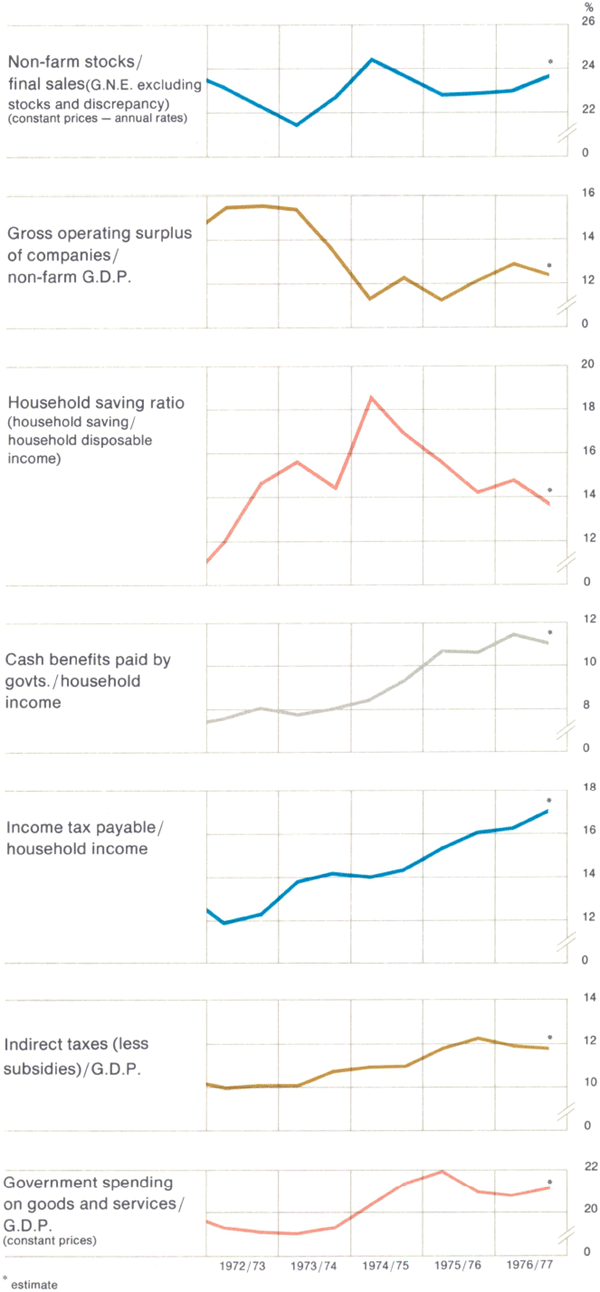
11 Gross Domestic Product
constant 1966/67 prices – seasonally adjusted
half yearly – annual rates
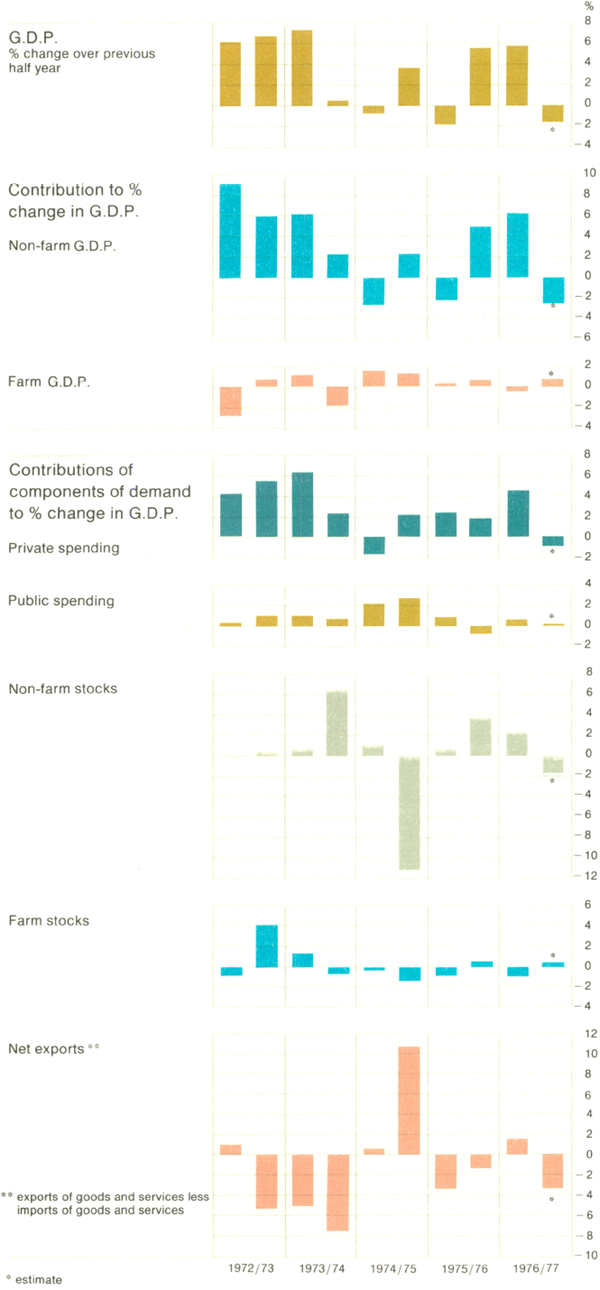
Investment in non-residential construction fell in 1976/77 by 13 per cent; this follows a fall of a similar magnitude in 1975/76. In real terms, this component of demand is now at about the same level as in 1966/67. However, data on approvals and commencements in nonresidential construction, together with expectations that some large mining projects could soon begin, suggest that a turning point may have been reached. But high interest rates, poor expected returns and large amounts of unused capacity in office buildings may dampen any increase in this spending aggregate.
Short-term movements in investment in plant and equipment have been erratic in recent years, with the timing of investment decisions affected, inter alia, by deadlines for qualifying for the double depreciation allowances in June 1975 and June 1976. As well, the investment allowance scheme introduced in January 1976 may have been instrumental in bringing some investment forward into the second half of 1975/76. There was a strong rise in investment in plant and equipment in the December quarter of 1976, to some extent reflecting, as for consumption expenditures, very large purchases of motor vehicles in December because of the expectation that prices would rise after the devaluation. Following this, investment in plant and equipment fell away over the second half of the year. Taken overall, this component of demand registered a net increase of around 6 per cent in 1976/77. Spending by commercial and non-manufacturing groups (excluding miners) and by manufacturers registered a small increase but, for the year as a whole, there was a large drop in mining investment. Indications were that mining investment was rising strongly, though from a low base, late in the year.
Growth in public spending on goods and services was subdued in 1976/77. Public spending was only about 1 per cent higher than in 1975/76; this compares with increases of 10 per cent and 4 per cent in 1974/75 and 1975/76 respectively. In terms of spending on goods and services, fiscal restraint bore more heavily on public capital expenditures which, in real terms, declined for the second successive year.
In the Commonwealth's Budget for 1976/77 total outlays, in nominal terms, increased by 10 per cent, less than half as fast as in 1975/76 and a quarter as fast as in 1974/75. Within the Budget, there was a sharp reduction in the rate of growth of payments to States (in part, though, this was the result of some prepayments to States late in 1975/76). The tightening also applied to other budget outlays and growth in cash benefits to persons — after allowing for the net effect of special factors (the switch from tax rebates for dependent children to family allowances and the changed arrangements for Medibank) — was also trimmed.
Growth in spending was curtailed at all levels of government in 1976/77; the increase (in nominal terms) in spending by state and local authorities in 1976/77, at about 13 per cent, was only slightly higher than that for Commonwealth Government authorities and well down on those of the previous two years.
Supplies
Both imports and domestic production contributed to the rise in the turnover of goods and services in 1976/77. Imports of goods and services rose by 11 per cent in 1976/77. With the arrival of goods apparently ordered and paid for earlier in anticipation of devaluation, a sharp increase in volume was recorded forthe middle quarters of the year. Bythe end of the financial year, with domestic demand still subdued and the effects of devaluation encouraging substitution to domestic sources of supply, imports began falling away. Notwithstanding these within-year fluctuations, the underlying trend of import growth was strong in 1976/77, particularly given the slackness in domestic demand. Factors in this trend were mentioned in the previous part of this Report.
Gross domestic product is estimated to have increased by close to 4 per cent in 1976/77. There was an increase of about the same size in real non-farm product and only a small rise in farm product. Movements in non-farm product during the year, as in the previous two years, were uneven with an increase of 7 per cent (seasonally adjusted annual rate) over the first half of the year, then a decline of 3 per cent in the second half of the year. A counterpart of the weakness in domestic production in that period was a rise in the proportion of final demand met from imports.
Industrial production also exhibited some within-year fluctuations and, at end May, as measured by the ANZ Bank index, was at about the same level as twelve months previously. Production rose steadily but slowly up till February, then declined in the ensuing three months. Both output of non-durable and durable goods rose early in the year but declined in the final months. There were, as usual, some divergent movements in the components of industrial production; chemicals and building materials and fuel and power — the more buoyant components of industrial production — rose by around 10 per cent; production of textiles, clothing and furniture and household goods fell by more than 5 per cent.
The setbacks to rural production from the drought which affected the south eastern parts of Australia during 1976 were less extensive than thought at the start of 1976/77. Increases in the production of sugar and meat about offset the falls in production of wool and wheat. Gross value of production rose by about 1 per cent and, with production costs rising at a similar pace, real gross farm product rose only slightly in 1976/77; in 1975/76, gross farm product had risen by 8 per cent.
12 Labour Market
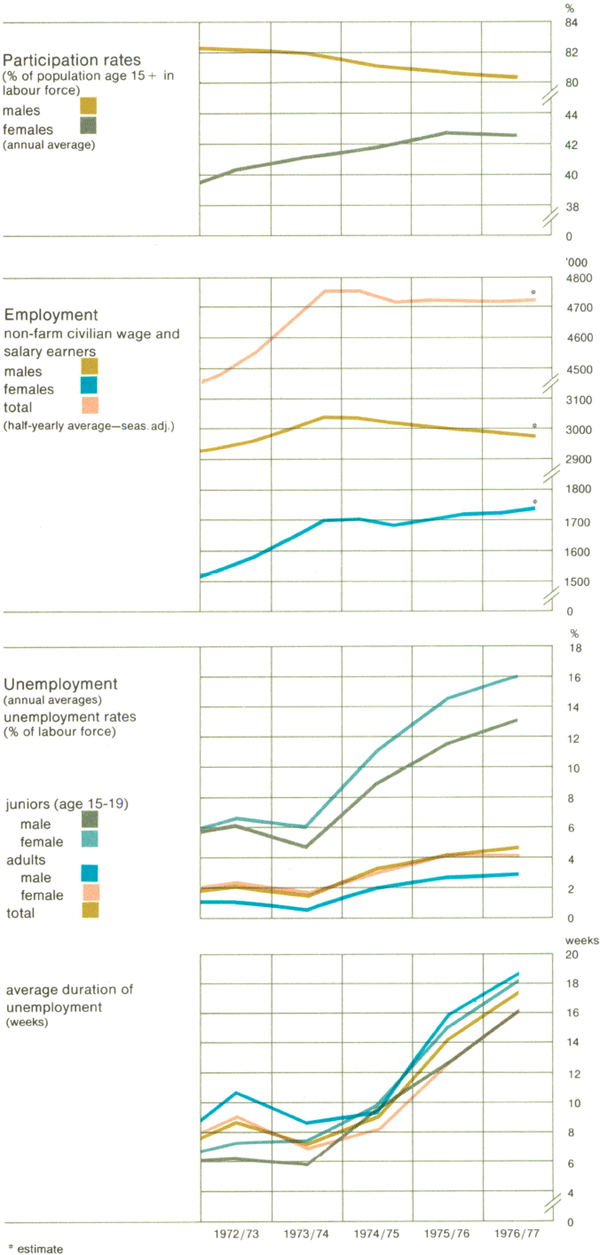
The Labour Market
The labour market weakened a little further in 1976/77. Demand for labour was generally unresponsive to the modest pick-up in activity. With an increase in the labour force of around 1 per cent, measured unemployment increased during the year. Population of working age grew by about 2 per cent but growth in the labour force was a little slower because of a decline in the proportion of the working age population actively in the labour force. In an economy with high unemployment, measured unemployment could be understating actual unemployment because some persons, particularly women, drop out of the labour force when employment prospects are poor. For males, the participation rate, which measures the proportion of the working age population in the labour force, declined in 1976/77, while the female participation rate was approximately steady. The fall in the male participation rate is a continuation of recent trends, but a steady female participation rate halts the past upward trend.
The number of non-farm civilian wage and salary earners remained almost unchanged during 1976/77 after declining during 1975/76; on average, however, numbers employed in both years were about the same. There was a decline in male employment but this was offset by an increase in the number of female employees. Private employment declined during the year; employment in service industries increased but there was a large fall in employment by manufacturing industries. For the full year, on average, private employment was lower than in 1975/76.
The winding down of special employment-creating schemes had resulted in a small fall in government employment during 1975/76; subsequently, public sector employment grew slowly during 1976/77. With lowered ceilings on staff numbers, employment in the Commonwealth Government sector declined; this was more than offset by a rise in employment in other public authorities.
The level of unemployment increased over 1976/77. The average unemployment rate (as measured by the labour force survey conducted by the Australian Bureau of Statistics) in 1976/77 was 4.8 per cent, 0.4 percentage points higher than in 1975/76. As measured by Commonwealth Employment Service statistics, total unemployed applicants averaged about 306,000 in 1976/77, about 30,000 above the average for 1975/76. Average duration of unemployment also lengthened further in 1976/77. For adults who were ‘unemployed during the year, the average duration of unemployment was 17.8 weeks; for juniors, it was 17.3 weeks.
As expected in an upturn, output began rising before employment; and output per employee rose by 4 per cent in 1976/77 compared with about 1 per cent in the previous year. The increase in output per employee has been comparable with that of previous upswings, but in earlier periods, the effect of increases in output on productivity were, after a time, dampened by increases in employment. The recent increases in output have not yet led to a pick-up in employment.
The slowness of employment to expand in response to the output gains and the current high unemployment reflect a number of influences, the main ones of which probably are the continued general weakness and hesitancy in aggregate demand and high labour costs. Over 1973 and 1974, increases in money wages far outran the upward movement in prices; real wages rose sharply, and, consequently, real labour costs rose at a rate substantially higher than labour productivity. Increases in real wages of junior males and females (and of unskilled workers) were considerably larger than those for adult males reflecting generally the form which wage increases took in those years — large increases in dollar amounts applied to all awards — and, in the case of women, expanded provisions for equal pay.
Other costs to employers arising from the employment of labour, such as payroll taxes, workers' compensation insurance, and fringe benefits such as leave loadings and extra annual leave, also rose substantially. These increases in costs outstripped the pace at which prices could be increased, particularly as demand slackened. There was a sharp reduction in profits, and employers shed labour at a rapid rate over late 1974 and early 1975. Over the last two years, wage indexation decisions have been the major influence on the level of money wages, and hence on real labour costs. The upward movement in labour costs has been slower, but indexation decisions have to a substantial extent maintained a high level of real earnings per employed worker. The increased relative cost of employing women and juniors has been at least maintained as one consequence of the use on several occasions of a “plateau” formula for indexation, which gives lower-paid employees, including juniors, females and the unskilled the largest percentage increases. In the face of sluggish real demand, it seems likely that the uneven incidence of unemployment, which is highest for juniors (particularly for females), may be in part attributable to the relative increase in their cost to employers.
Prices
Rates of increase in most price indexes were lower in 1976/77 than in the previous two years. As Chart 13 shows, the slowing in price rises was marked during the first half of the year.
The index of price movements derived from comparison of the Australian Statistician's current and constant price estimates of gross national expenditure (the “implicit deflator”) rose by about 12 per cent in 1976/77, around 4 percentage points less than in 1975/76. The consumer price index rose by a little under 14 per cent in 1976/77, about 1 percentage point more than in 1975/76. Movements in this index in both years were affected by changed arrangements for the payments of hospital and medical services. Excluding price changes for hospital and medical services, the increase in the consumer price index in 1976/77 was 11.4 per cent against 15.6 per cent in 1975/76.
13 Incomes, Costs and Prices
percentage change over previous half year
seasonally adjusted – annual rates
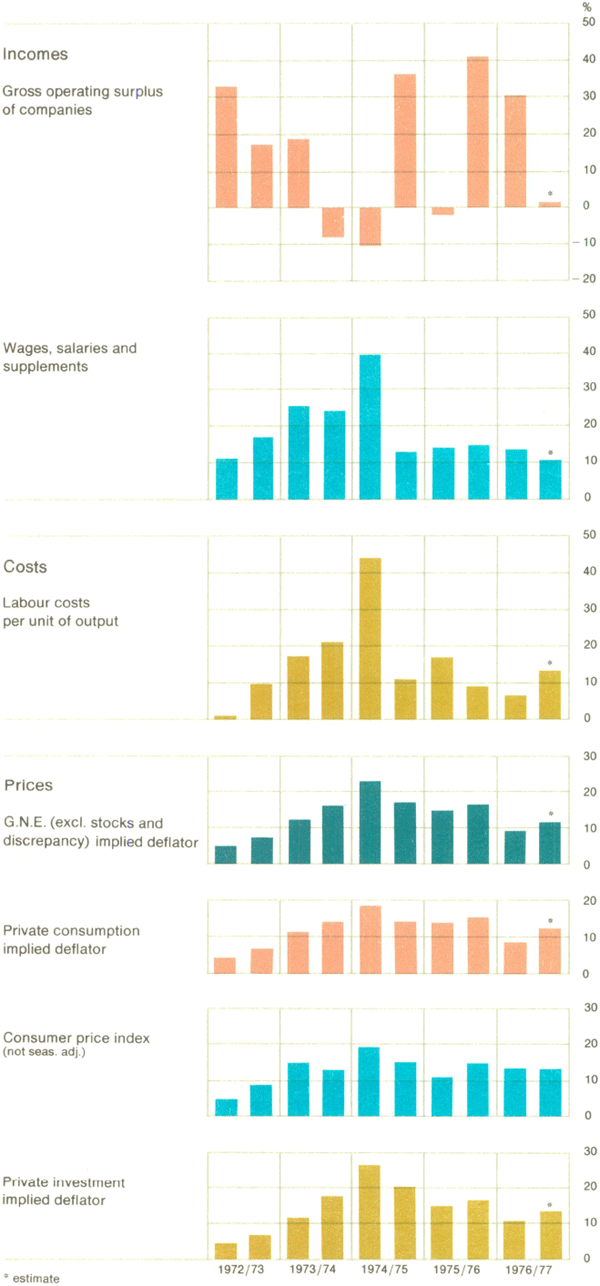
The rate of inflation slowed in the first half of 1976/77. As measured by the implicit price deflator for private consumption in the national income accounts, the rate of price increase was almost halved; over the second half of 1975/76, this indicator had risen by almost 16 per cent (seasonally adjusted annual rate) but, in the next half year, the annual rate of increase was down to 9 per cent. The corresponding increases (at annual rates) in the consumer price index (excluding health services) over the two half years were 15 per cent and 10 per cent. The slowdown also reflected in price indexes with a broader coverage; for example, the implicit deflator for non-farm product increased by 9 per cent in the first half of 1976/77 compared with 15 per cent in the previous half year.
Subdued domestic demand and competition from imports probably played a role in the lower rates of price increase; a further element was a slowdown in the rate of increase of the cost of labour. Over 1974 and 1975 labour costs per unit of non-farm output had increased by 26 per cent and 19 per cent respectively; over calendar 1976, the increase was about 10 per cent.
Indications are that the slowing trend of price increases did not extend into the second half of the year, in part reflecting increases which flowed from devaluation. The consumer price index (excluding hospital and medical services) increased by a little over 10 per cent (annual rate) in the second half of the year, about the same pace as in the first half. Devaluation effects in the second half of the year were more clearly reflected in the broader based national accounts implicit price deflators, which rose rather more quickly, particularly in the March quarter.
Incomes
Total income (gross domestic product at factor cost) grew by about 16 per cent in 1976/77 compared with increases of much the same size in the previous two years and 21 per cent in 1973/74.
Growth in average earnings per employed male at about 13 per cent in 1976/ 77 was a littleslowerthan in 1975/76. With overtime worked and average employment showing little change, wage incomes increased during the year mainly with the growth in award wages, which for adult males increased by 13 per cent, slightly less than in 1975/76. Increases in awards came mainly from the four National Wage case decisions by the Arbitration Commission during the year; increases in awards from other factors were minimal. The decisions involved a mixture of partial and full indexation of award wages to increases in the consumer price index, with one decision (that of November 1976) granting full indexation of all award rates, and the other three (in August 1976, March and May 1977) granting varying degrees of partial indexation.
Non-wage incomes, which account for around one-third of household incomes, grew quickly in 1976/77. For non-farm unincorporated enterprises the increase was a little lower than the 20 per cent increase recorded in 1975/76. Farm unincorporated incomes rose by about 8 per cent in 1976/77 following three unfavourable years when nominal incomes declined by a total of around 40 per cent.
Growth in cash benefits paid by governments was lower than in the previous two years; nevertheless, with payments under the changed system of family allowances more than offsetting the reduction of the flow of health insurance payments, cash benefits to persons rose by 20 per cent. Total household incomes increased by some 15 per cent in 1976/77, about 2 per cent less than in the previous year. Because of the abolition of tax rebates for children and because of the collection of the Medibank levy, growth in personal taxes outstripped that in incomes despite tax indexation. Overall, household disposable income in 1976/77 increased by about 14 per cent in nominal terms, which implies little net increase in real terms for the second successive year.
Corporate incomes increased strongly in 1976/77. The increase in gross operating surplus of corporate trading enterprises of about 25 per cent in 1976/77 followed an increase of 17 per cent in 1975/76 and, in both years, the rises were greater than the average for all incomes. Accordingly, the share of corporate profits in total incomes moved up further though it remained below the average levels of years prior to 1974/75. With real wage incomes for the bulk of the labour force tending to be maintained by current award wage indexation arrangements, the recovery in profitability and hence in investment and private employment hinges largely on improvements in productivity.
Growth in the incomes of public authorities was slower than in recent years. Receipts from public enterprises grew less rapidly than in 1975/76, when charges for a number of services were substantially increased. Tax receipts, which provide around 90 per cent of total public sector receipts, are estimated to have increased by around 16 per cent in 1976/77 compared with increases of 29 per cent and 20 per cent in 1974/75 and 1975/76 respectively. Direct taxes increased by 18 per cent and, with few changes in rates, indirect tax collections increased by about 13 per cent.
The net outcome, by sectors, of income and expenditure transactions in 1976/77 was broadly similar to that of the previous three years. The household sector of the economy remained in substantial surplus; the surplus was smaller in 1976/77, as growth in expenditure was more rapid than growth in income. The borrowing requirement of non-financial corporate enterprises was about the same as in 1975/76. The surplus recorded for the rest of the world (which implies that Australia was a net borrower) increased. The public sector was, as in the previous two years, the largest borrowing sector.
These sectoral positions had an important bearing on trends in financial flows in 1976/77, which are discussed in the next part of this Report.